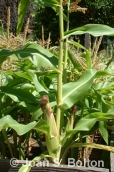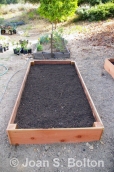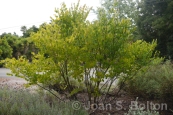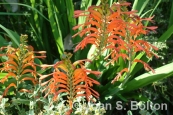
It’s a new year. And with it comes an opportunity to approach your garden with a fresh eye.
Month by month, here’s what to expect on the Central Coast during the gardening year.
January
January kicks off bare-root season.
Roses, deciduous fruit trees and even a few perennial vegetables, including asparagus and artichokes, can be planted this month and next. Bare root plants are dormant: all you’ll see is a twiggy stick or two, attached to spidery roots.
For roses, select varieties that do well in cooler, coastal climates. For edibles, choose types that are low-chill, which means they don’t need more than a few hundred “chill hours” below 45 degrees between November and March to set fruit and grow properly.

Be sure when planting bare-root that your soil is dry enough to work. That may be tricky with our recent, drenching rain. If you miss the window now, you’ll get a second chance in spring, after nurseries pot up their bare-root stock and sell the plants in traditional containers.
Existing roses and deciduous fruit trees need pruning, too. Clean up and clear out twiggy, broken or crossing branches to prepare for new growth, blooms and fruit in the coming year.
In the vegetable garden, there’s time to plant another few rounds of fast-growing lettuce, spinach and leafy greens. But it’s too late for broccoli, cabbage or other bigger, cool-season crops.
Camellias, azaleas and other hardy shrubs can go in now. But don’t plant if the soil is too wet. If you can’t resist a particular new plant, temporarily pot it up, then transplant it in spring.
If temperatures drop dramatically, protect any frost-sensitive plants by keeping them well watered. Also cover them with a bed sheet or lightweight plastic at night. Remove the cover in the morning to avoid trapping daytime heat, which can turn the space underneath into a hothouse.
February

If temperatures haven’t warmed, February in the garden is nearly a carbon copy of January, with bare-root planting and bare-root pruning continuing in earnest.
Don’t prune any plants other than those that are dormant, such as your roses and deciduous trees. Ignore any old, leggy growth on perennials, such as Mexican sage, lavender and the like. Even though it’s unsightly, that scraggly stuff will help insulate the plants if frost persists. You can trim them toward the end of the month, once the threat of frost has passed.
Also toward the end of the month, start planting summer-blooming bulbs, such as tuberous begonias, caladiums, calla lilies, dahlias, gladiolus and Mexican tuberose. Check that the soil is workable, as these bulbs don’t like to sit in chilly, wet dirt.
March

With March comes spring. The danger of frost ebbs, the soil warms up and dries out, and wriggly earthworms appear.
At the beginning of the month, plant annuals and hardy perennials, shrubs, vines and trees. By the end of the month, you can turn to citrus, tropicals and succulents, which need warmer days to get going.
Longer days and increasing temperatures will send weeds into high gear. Remove them as fast you can — or at least their tops, so they don’t set seed.
Adjust your irrigation controller, which should have been set to rain delay or dialed back to infrequent cycles over the cooler, wetter months.
April
By April 1, your first tomatoes can go in the ground. In fact, last year I planted my first tomatoes March 31, and those eight plants outperformed three later plantings by a landslide.
Start seed of other summer vegetables, such as peppers, eggplant and zucchini. But wait for warmer nighttime temperatures before transplanting them into the garden.
Celebrate Earth Day mid-month by setting up a compost pile, freshening mulch in your planting beds or taking a vow to reduce or eliminate the use of herbicides or pesticides in your garden.
Catch up on planting roses or deciduous fruit trees that you missed during bare-root season.
May
Despite any May gray, this is a glorious month for planting everything from bright summer color in patio containers and hanging baskets to sowing pumpkin seeds directly in the ground in your vegetable garden.
More structural plantings can go in as well. Plant foundation shrubs to plug gaps or serve as hedges. Plant shade trees on the south and west sides of your house to reduce cooling costs during summer.

May is also an excellent time — it’s not too cold and not too hot — to install a sod lawn. To conserve water and time tending the swath, don’t carpet your entire yard. Instead, lay down sod only where you truly need it for children or dogs to romp.
Or replace your existing, thirsty turf with a lumpy, no-mow grass, such as our native California meadow sedge (Carex praegracilis) or blue sedge (Carex flacca). Red fescue (Festuca rubra), which forms flattened drifts in the shade, requires a little more water. But it grows well on slopes that are difficult to mow.
June

Keep planting those vegetables. Sow big-seed veggies, such as corn, pumpkins and melons, directly in the ground. Even with any June gloom, night-time temperatures should be sufficient to move peppers and eggplant outdoors. Sow sunflowers, too. Look for the pollenless types if you plan to harvest the cheery flowers for indoor arrangements.
Plant annual herbs in pots or in the ground. Basil, borage, chamomile, parsley and summer savory are happy just about anywhere. Caraway, cilantro and dill should be grown in the ground only, as all three send down tap roots that aren’t content in shallow containers.
Check or revamp your irrigation system in advance of summer heat. If you have sprinklers in a planting bed of mixed heights, the taller plants may be blocking the spray. If so, retrofit the system with drip tubing and emitters that snake their way through the plants and apply water at ground level.
July

By July, any new plantings should be humming along and you can turn your attention to nipping and tucking around the edges.
Trim any wayward growth or crossing branches on trees and shrubs. Shear or dead-head spent flowers on perennials to encourage repeat blooming.
Tune up your summer roses by cutting them back by one-third to a half after they’ve finished their July bloom cycle. This will force new growth for bigger flowers in fall and again just before Christmas.
The June gloom is likely to be a distant memory, so increase the frequency of your irrigation — especially for hanging baskets and containers, which dry out faster than plants in the ground.
August

Other than keeping after errant weeds, harvesting summer edibles and making sure your plants are well-watered, there’s not a lot to do.
Indeed, this month may be our closest equivalent to the down time that eastern gardeners enjoy during snowy months. Although instead of curling up next to the fireplace with a warm beverage and a handful of gardening catalogs, we’re likely to be at the beach, on vacation or simply spending time outside, enjoying our gardens.
From that standpoint, August is a good time to re-think your outdoor space. If you’re so inclined, install a bench, water feature or outdoor lighting.
Or take on a construction project, such as building a raised bed, trellis or arbor.
September

September starts off slowly. But as the days become noticeably shorter toward the end of the month, my favorite time of the year in the garden begins.
Fall planting brings with it the potential to truly change the character of a garden, providing an opportunity to plant sweeps of ground covers, perennials, shrubs and trees — with the best choices being California natives or plants hailing from other Mediterranean climates that are naturally adapted to our cycle of warm, dry summers and cool, wet winters.
Even if you make only a few changes or additions, these plants will be off to their best start when planted in fall.

Or you can honor the season by slipping in a few South African bulbs, such as naked lady (Amaryllis belladonna), baboon flower (Babiana), Chasmanthe, Crinum, Freesia, wand flower (Ixia), chincherinchee (Ornithogalum thyrsoides) or Velthemia, which will bloom in late winter or spring.
As for watering: dial it back for everything except your newly planted plants.
October
Let the fall planting frenzy continue.
Also begin setting out cool-season vegetables, such as beets, bok choy, broccoli, cabbage, carrots, cauliflower, kohlrabi, leafy greens, leeks, radishes and Swiss chard.
November
The nights are growing nippy and the days are even shorter. But there’s still time to squeeze in quick winter color by planting pansies, violas, cyclamen, primroses and sweet peas in beds or along walkways right around your house.
At the end of the month, harvest bright berries and colorful fallen leaves for holiday decorations.
December

With the advent of winter rains, the window for planting may be coming to an end. But you’ll likely be facing piles of leaves and other detritus. Put the remains to good use by setting up a compost pile. Use a store-bought bin, or construct one out of four 4″x4″ redwood posts, slats and a tarp.
Check your winter vegetables for slugs and snails. Use a non-toxic bait, such as Sluggo, to keep the pests under control.
If you have dirt walkways that dissolve into mud every winter, lay down flagstones or rough-textured mulch at least 3 to 4 inches deep to keep the muck off your shoes.
Set your irrigation controller to rain delay or turn it off entirely if we have another wet winter.
≈
Seeds of Wisdom
While we can usually tackle specific tasks during specific months, much of what we accomplish in our gardens is ultimately dependent on the weather.
This past year, who would have expected such a cool summer, followed by a dash of record-breaking heat, then a thorough dousing of rain? That unpredictability requires a certain dose of flexibility when gardening from one season to the next.
≈
Copyright, Joan S. Bolton. All rights reserved. Reproduction of text or photos in any form is prohibited without written permission.
≈
